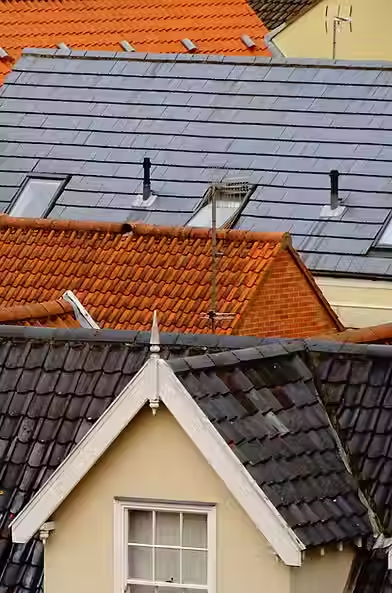Pitched Roofs: Pros, Cons, Repairs & Replacement
- Steve Roofer
- Jun 7
- 4 min read
Updated: Jun 29
When people imagine a traditional home in the UK, especially around London, chances are they're picturing one with a pitched roof.
Whether it’s the Victorian terraces in the inner city or the post-war homes further out, pitched roofs are iconic—and for good reason. They’re durable, practical, and surprisingly versatile. But like all things, they have their drawbacks too. So if you're wondering whether a pitched roof is right for your home – or if it’s time to repair or replace the one you've got – read on.
What Exactly Is a Pitched Roof?

A pitched roof is any roof with a sloped surface, usually with two sides that meet at a ridge in the middle. The steepness of the slope can vary dramatically. Some are quite shallow, while others form sharp, dramatic peaks.
This sloped design isn’t just for show. It’s built to shed water and snow efficiently, which matters more than you might think in our famously rainy climate.
The Pros of Pitched Roofs
1. Long Lifespan: A well-built pitched roof can last anywhere from 40 to 100 years, depending on materials. Slate and tile, in particular, stand the test of time.
2. Great for Water Drainage: Unlike flat roofs that can struggle with pooling, pitched roofs allow rainwater to run right off. That means less risk of leaks and structural water damage.
3. Extra Space: Loft conversions wouldn’t exist without pitched roofs. Whether you’re storing boxes or dreaming of an extra bedroom or home office, the angle of the roof creates usable space.
4. Aesthetic Value: There’s something about a pitched roof that gives a home charm. It’s part of the reason they remain so popular in residential areas.
The Drawbacks
1. More Expensive to Build and Repair: It’s true—pitched roofs cost more upfront than flat alternatives. They also take longer to install due to their complex structure.
2. Harder to Access: Routine maintenance, gutter cleaning, and repairs can be trickier. Most of the time, you’ll need a roofing specialist.
3. Susceptible to Wind Damage: In areas with strong winds, pitched roofs can catch more force and suffer more damage if not properly secured.
When Is Repair Better Than Replacement?
That depends on the age of your roof, the extent of the damage, and whether the underlying structure is still sound.
Signs your pitched roof may only need repair:
A few missing or broken tiles
Localised leaks (especially around chimneys or roof valleys)
Flashing that’s come loose
Moss buildup
These are generally straightforward fixes that a skilled roofer can sort without needing to tear everything off.
But when is it time for a full replacement?
If your roof is over 50 years old and has widespread wear
If there’s structural damage from water infiltration
If you’ve had recurring issues year after year
In these cases, patching things up may be throwing good money after bad.
What’s Involved in a Pitched Roof Repair?
At Roof Local, we begin with a thorough inspection to identify where problems lie – often it's not where the leak appears inside. Once we’ve pinpointed the issue, we offer options tailored to your roof's age and material.
Repairs can involve:
Replacing broken or slipped tiles
Reinforcing underlayment
Repairing flashing around chimneys or dormers
Fixing damaged ridge tiles or hip tiles
We’ll always discuss options and give you the pros and cons of each approach, so you stay in control.
What Happens During a Roof Replacement?
It’s a bigger job, but we make the process smooth and stress-free. After the old roof is stripped back, we check the timber frame and insulation. If all is sound, we’ll install a breathable membrane, battens, and your chosen tile or slate. Everything is built to current UK standards with attention to detail, from ventilation to finishing touches.
Many clients worry about disruption. The good news? Most pitched roof replacements are done in a matter of days, and we tidy up after ourselves.
Pitched Roof Materials: What Are Your Options?
When replacing or building from scratch, you’ve got choices:
Clay Tiles: Classic, earthy, and long-lasting.
Concrete Tiles: Affordable and available in various colours.
Slate: Elegant and durable, though heavier and pricier.
We’ll help you weigh the pros and cons based on your home’s structure, budget, and style.
A Quick Note on Regulations
If you're in a conservation area or listed building, there may be restrictions on what changes you can make. Don’t worry—we’ll walk you through it. We deal with local council regulations regularly.
The Emotional Side of Roofing
It might seem like just bricks and tiles, but your roof is your first line of defence. When it fails, it creates anxiety. The dripping ceiling, the damp patches – it’s unsettling.
That’s why our job isn’t just technical. We’re here to give peace of mind.
We don’t just repair roofs. We restore confidence.
Final Thoughts: Is a Pitched Roof Right for You?
If you value longevity, energy efficiency, and classic style, a pitched roof is worth the investment. Repairs, if handled early, can add decades to its life. And when it comes time to replace, a new pitched roof increases property value and aesthetic appeal.
Need help assessing your roof’s condition? Wondering whether to repair or replace? Contact Roof Local today – we’ll take a proper look and guide you with no pressure.



Comments